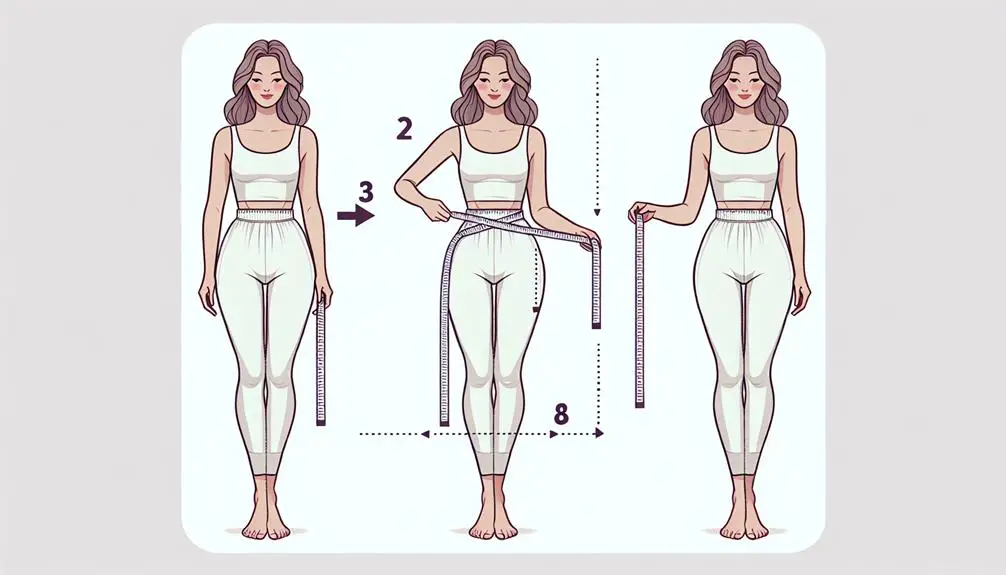When it comes to measuring the high hip, it's a bit like finding the perfect balance in a recipe – crucial yet often overlooked.
The high hip measurement can be a game-changer when it comes to achieving a flattering fit in your clothing. Imagine being able to tailor your skirts and pants to hug your curves in all the right places.
Understanding how to measure your high hip accurately can make a world of difference in your wardrobe.
Curious to discover the secrets behind this essential measurement?
Table of Contents
Key Takeaways
- High hip measurement is crucial for achieving a flattering fit in clothing.
- Proper placement of the measuring tape around the widest part of the hips at the top of the hip curve is necessary.
- Customizing patterns based on high hip measurements ensures a perfect fit.
- Understanding the differences between front and back high hip measurements is important.
Importance of High Hip Measurement
Why is measuring the high hip so crucial for achieving a perfect fit in skirts and pants?
The high hip measurement plays a pivotal role in ensuring that skirts and pants drape elegantly over the body. Unlike the full hip measurement, which captures the widest part of the hips, the high hip measurement specifically targets the top of the hip curve. By accurately measuring the high hip, tailors and designers can create garments that hug the body in all the right places, enhancing both comfort and style.
When measuring the high hip, it's vital to keep the tape level to obtain precise numbers for pattern adjustments. Understanding the distribution of hip measurements between the front and back high hip points is essential for creating well-balanced garment designs. By tailoring patterns to suit individual body shapes, accounting for factors like uneven hips and waist-to-hip ratios, the perfect fit can be achieved through meticulous high hip measurements.
Tools Needed for Measuring High Hip
To measure the high hip accurately, you'll need a soft cloth measuring tape, ensuring flexibility and precision.
Placing the tape at the top of the hip curve while keeping it level is crucial for obtaining an accurate measurement.
Remember to record your measurements meticulously to guarantee proper fitting garments.
Measuring Tape Selection
When selecting a measuring tape for high hip measurements, opt for a soft cloth tape to ensure flexibility and comfort. Using a metal measuring tape may lead to discomfort or inaccurate readings, so it's best to avoid them.
Printable tape measures from the internet can also be used for accurate high hip measurements as an alternative option. Remember to keep the measuring tape parallel to the ground for precise readings. Be careful with printable tape measures to prevent ripping and maintain accuracy.
Here are some key points to consider when choosing a measuring tape:
- Choose soft cloth material for flexibility and comfort.
- Avoid metal tapes to prevent discomfort or inaccuracies.
- Use printable tape measures as an alternative for accurate readings.
Proper Hip Placement
Choosing the right tools for measuring the high hip accurately is essential to ensure precise results and comfortable adjustments. When measuring hip measurements, it's crucial to use a soft cloth measuring tape for accuracy.
Start by positioning the tape around the widest part of your hips, typically at the top of the hip curve. To get the most precise measurement, make sure the tape is level and parallel to the ground.
Recording Measurements Accurately
For precise and comfortable high hip measurements, opt for a soft cloth measuring tape to ensure accuracy and ease during the process.
When recording measurements, follow these key steps:
- Keep the measuring tape level around the high hip area to obtain accurate readings.
- Avoid using metal measuring tapes, as they can cause discomfort and lead to incorrect measurements.
- Record the high hip measurement in both inches and centimeters for comprehensive reference. Double-check the recorded measurement to guarantee precision before utilizing it for garment fitting.
Preparation Before Measuring High Hip
To ensure accurate measurements for your high hip, it's essential to wear form-fitting clothes or underwear. This helps in defining the hip area clearly and ensures that the measuring tape sits properly. Form-fitting attire allows for a more accurate representation of the natural curves and contours of your body, giving you precise high hip measurements. When the clothes are loose, the measuring tape mightn't sit around the back and front part of your hips as intended, leading to inaccurate results.
Before starting the measurement process, make sure to stand with your feet close together. This position helps maintain proper alignment and posture for measuring the high hip accurately. Using a soft cloth measuring tape is crucial as it prevents discomfort and allows for flexibility when measuring the top of the hip curve. Remember to keep the measuring tape level around your body to ensure consistent and precise high hip measurements.
Proper Body Positioning for High Hip Measurement
When measuring the high hip, correct body alignment and an optimal measurement technique are key.
Ensuring that your posture is straight and your hips are level will give you the most accurate measurement.
Correct Body Alignment
Achieving correct body alignment is fundamental for precise high hip measurements, ensuring accurate reflection of the body's natural curves. To achieve this, follow these crucial steps:
- Stand Properly: Align your body straight with feet together to establish the correct posture for high hip measurement.
- Level Measuring Tape: Keep the measuring tape parallel to the ground to maintain consistency in the measurement process.
- Place Tape Correctly: Position the measuring tape at the top of your hip curve, above the hipbones, to accurately measure the high hip area.
Optimal Measurement Technique
Properly positioning your body is key when measuring the high hip to ensure accurate results that reflect your natural curves. When taking the high hip measurement, make sure to stand up straight with your feet together. Place the measuring tape around the part of your hips that aligns with the top of your hip curve, above the hipbones. Ensure that the tape is parallel to the floor to maintain consistency. Remember, this measurement is crucial for garment fitting, so accuracy is essential. Understanding the difference between the high hip and full hip measurements is also important for a precise fit. Check out the table below for a quick recap:
| High Hip Measurement Technique |
|---|
| Stand up straight with feet together |
| Place tape around the top of the hip curve, above hipbones |
| Keep the tape parallel to the floor |
| Ensure accuracy for precise garment fitting |
| Understand the difference between high hip and full hip measurements |
Steps to Measure High Hip
To accurately measure the high hip, start by positioning the measuring tape at the top of the hip curve. Once you have the tape in place, follow these steps:
- Wrap the tape around: Make sure the tape is snug but not tight around the top of the hip curve. It should sit parallel to the floor for an accurate measurement.
- Take the measurement: Note the measurement where the tape meets, ensuring it captures the fullest part of the high hip but doesn't slip down to the full hip area.
- Record the measurement: Jot down the measurement accurately to refer back to for pattern making or fitting purposes.
Recording High Hip Measurements
When recording high hip measurements, ensure the tape is snug but not tight around the top of the hip curve for accuracy. This measurement is crucial, especially when fitting skirts or pants to ensure they sit correctly on the body.
To record the high hip measurement accurately, I make sure the tape is parallel to the floor to maintain consistency. This step is essential to get a true representation of the hip curve and guarantee a well-fitted garment.
Knowing the high hip measurement is particularly helpful for tailoring clothes like a pair of pants, where the fit around this area significantly impacts comfort and style. By taking this measurement precisely, I can create garments that flatter the body shape and provide the right level of comfort.
Tips for Accurate High Hip Measurement
For a precise high hip measurement, position the measuring tape snugly but comfortably at the top of the hip curve. When measuring the high hip for fashion design purposes, accuracy is key. Here are some tips to ensure you get the most accurate measurement possible:
- Wrap the tape measure: Start by wrapping the measuring tape around the body at the top of the hip curve, ensuring it sits level all the way around.
- Avoid tilting: Keep the measuring tape parallel to the floor to prevent any tilting that could skew the measurement.
- Take multiple measurements: To ensure accuracy, it's a good practice to take multiple measurements and calculate the average to get the most precise high hip measurement for your garment designs.
Benefits of Knowing Your High Hip
Understanding the benefits of knowing your high hip measurement greatly enhances your ability to achieve a perfect fit in your clothing. By being aware of your hip measurement, especially in the high hip area which sits around the hip bones and is different from the natural waist, you can make a big difference in how your skirts and pants fit.
| Benefits of Knowing Your High Hip |
|---|
| Helps achieve proper fit for skirts and pants |
| Ensures garment balance |
| Reveals body shape variations |
| Enhances garment fit and comfort |
Knowing your high hip measurement allows you to tailor patterns to your individual shape, ensuring a comfortable and balanced garment construction. This understanding is key to customizing patterns for a perfect fit, as differentiating between front and back high hip measurements can reveal variations in body shape that standard sizes might not accommodate. Mastering your high hip measurement opens up a world of possibilities for creating clothing that fits you like a glove.
Frequently Asked Questions
Where Do You Measure Your High Hip?
At the top of my hip curve is where I measure my high hip. It's a key spot for getting skirts and pants to fit just right. Keeping the tape level is crucial for accuracy.
What Is the Difference Between High Hip and Full Hip?
The difference between high hip and full hip measurements is crucial for garment fitting. High hip is at the top of the hip curve, while full hip represents the widest part. Understanding this variance aids in achieving tailored perfection.
What Is High Hip Waist Measurement?
High hip waist measurement is the top part of the hip curve, crucial for tailored fits in skirts and pants. Understanding its significance in garment design choices impacts accuracy. Keeping the tape level ensures precise measurements.
What Is a High Hip?
A high hip is the top curve of the hip, crucial for accurate skirt and pant fitting. It differs from the full hip, which is the widest part. Knowing this distinction is vital for achieving the right garment fit.
- Top Suppliers of Tetron Fabric in India - June 17, 2025
- Tetron Fabric Wholesale: Top Suppliers and Manufacturers - June 17, 2025
- Tetron Fabric Price in the Philippines: A Detailed Look - June 17, 2025



